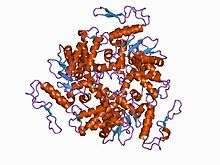HECT domain
In molecular biology, the HECT domain is a protein domain found in ubiquitin-protein ligases. The name HECT comes from 'Homologous to the E6-AP Carboxyl Terminus'.[1] Proteins containing this domain at the C terminus include ubiquitin-protein ligase, which regulates ubiquitination of CDC25. Ubiquitin-protein ligase accepts ubiquitin from an E2 ubiquitin-conjugating enzyme in the form of a thioester, and then directly transfers the ubiquitin to targeted substrates. A cysteine residue is required for ubiquitin-thiolester formation. Human thyroid receptor interacting protein 12 (TRIP12), which also contains this domain, is a component of an ATP-dependent multisubunit protein that interacts with the ligand binding domain of the thyroid hormone receptor. It could be an E3 ubiquitin-protein ligase. Human ubiquitin-protein ligase E3A interacts with the E6 protein of the cancer-associated Human papillomavirus type 16 and Human papillomavirus type 18. The E6/E6-AP complex binds to and targets the p53 tumour-suppressor protein for ubiquitin-mediated proteolysis.
| HECT-domain (ubiquitin-transferase) | |||||||||
|---|---|---|---|---|---|---|---|---|---|
 structure of an e6ap-ubch7 complex: insights into the ubiquitination pathway | |||||||||
| Identifiers | |||||||||
| Symbol | HECT | ||||||||
| Pfam | PF00632 | ||||||||
| InterPro | IPR000569 | ||||||||
| SCOPe | 1d5f / SUPFAM | ||||||||
| |||||||||
References
- Huibregtse JM, Scheffner M, Beaudenon S, Howley PM (March 1995). "A family of proteins structurally and functionally related to the E6-AP ubiquitin-protein ligase". Proc. Natl. Acad. Sci. U.S.A. 92 (7): 2563–7. doi:10.1073/pnas.92.7.2563. PMC 42258. PMID 7708685.